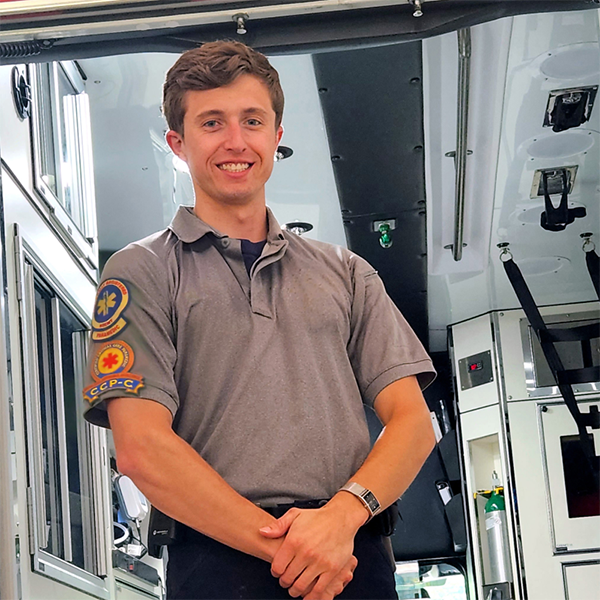The challenges of emergency medical services in rural areas
Delivering emergency medical services in rural settings creates a distinct set of challenges.
“Transport from the patient’s home to the nearest critical access hospital might take 30 to 50 minutes,” said Hunter Burnette, a nationally registered paramedic (NRP). He works in a part of western North Carolina that falls within Appalachia’s southern region.
“It takes self-reliance and good clinical assessment skills. We don't have a lot of resources that are readily available like inner-city settings do, including personnel and even advanced technology.”
Burnette’s patients span a wide range of ages. “We see everything from the smallest neonate, down to 4 kilograms, up to geriatric patients. I had a patient yesterday who was 93 years old,” he said.
The 23-year-old Burnette is also a critical care paramedic. “We do critical care interfacility transfers from small critical access facilities to level 1 trauma centers,” he explained.
Time and training are of the essence to paramedics when triaging critically ill patients and getting them the level of care they need. It’s also an asset to have the best clinical tools.
Burnette first discovered the 3M™ Littmann® CORE Digital Stethoscope in 2021 on social media. “I’m not usually influenced by social media, but I often follow cardiologists and a lot of cardiologists were using the Littmann® CORE,” he explained.
“As an emergency medical services provider, many of the settings we go to are loud,” he said. “The Littmann® CORE’s noise cancelling technology and ability to amplify sounds were super appealing to me.”
Burnette later learned of a trial to study the Eko CORE 500™Digital Stethoscope and signed up to participate in that research.
How the Eko CORE 500™ helps paramedics expedite emergency medical services
For Burnette, the Eko CORE 500™ helps paramedics like him expedite emergency medical care. The technology allows clinicians to see a patient’s cardiac rhythm quickly and clearly on a color screen while listening to their heart sounds.
“If the patient has bradycardia (a slow heart rate), you can feel that. If you place the Eko CORE 500™ on their chest and use the 3-lead ECG (electrocardiogram), you may realize that they’re in second-degree heart block. Then, once confirmed, you can administer atropine and expedite the process."
The wireless capability enables hands-free listening. “A lot of people are astonished about the Bluetooth feature that allows you to visualize and record heart sounds on the phone in seconds,” Burnette said.
Another advantage of the CORE 500™ sound technology comes after performing an emergency intubation to establish an airway. The digital stethoscope’s TrueSound™ technology, plus 40x amplification and active noise cancellation, can help paramedics easily determine that the airway is moving air into the lungs, and not into the stomach.
He finds the mobile app useful in recording and storing information on a patient’s heart and lungs. This can help the hospital team understand the patient’s vital body sounds both pre- and post-emergency medical treatment. “Having evidence of what you first heard on the scene, during a 40-minute transport and treatment — and being able to give that data to the clinical team when you arrive — is substantial,” Burnette noted.
Fielding a career path as a paramedic
Burnette, a North Carolina native, is an avid fan of the outdoors. “In my free time, I’m a fly fisherman. I pretty much do any type of outdoor recreational activity,” he said. He originally planned to practice criminal justice as a wildlife officer.
He took a summer off from playing collegiate baseball in his freshman college year. During his break from baseball, Burnette joined the fire department and became certified as an EMT in 2017.
“I started taking biology courses, and I realized biology and medicine and the EMT work had a lot of overlap. I was fascinated with pathology, microbiology, and chemistry. That inspired me to progress with my clinical care and practice.”
Advancing his career path, Burnette graduated with his master’s in public health (MPH) from East Tennessee State University. Today, he continues work as a paramedic while also pursuing his degree as a Doctor of Osteopathic Medicine, now a first-year medical student.
As he continues his education, Burnette’s experience as a first responder reflects his interests in trauma surgery and critical-access medicine. He is keeping his practice options open, but his aspiration is to become a healthcare executive, working to transform the lives of people in communities.
Discover why the Eko CORE 500™Digital Stethoscope is such a powerful tool for paramedics in emergency medical services.
MKT-0002275 Rev 1.0
